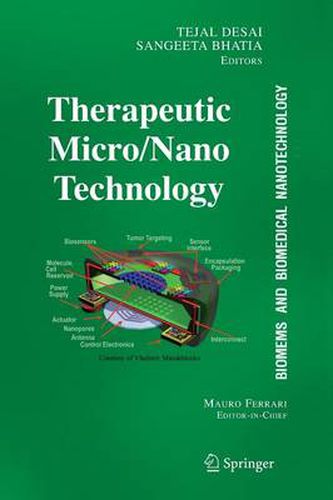Readings Newsletter
Become a Readings Member to make your shopping experience even easier.
Sign in or sign up for free!
You’re not far away from qualifying for FREE standard shipping within Australia
You’ve qualified for FREE standard shipping within Australia
The cart is loading…






This title is printed to order. This book may have been self-published. If so, we cannot guarantee the quality of the content. In the main most books will have gone through the editing process however some may not. We therefore suggest that you be aware of this before ordering this book. If in doubt check either the author or publisher’s details as we are unable to accept any returns unless they are faulty. Please contact us if you have any questions.
Less than twenty years ago photolithography and medicine were total strangers to one another. They had not yet met, and not even looking each other up in the classi?eds. And then, nucleic acid chips, micro?uidics and microarrays entered the scene, and rapidly these strangers became indispensable partners in biomedicine. Asrecentlyastenyearsagothenotionofapplyingnanotechnologytothe?ghtagainstd- ease was dominantly the province of the ?ction writers. Thoughts of nanoparticle-vehicled deliveryoftherapeuticalstodiseasedsiteswereanexerciseinscienti?csolitude,andgrounds for questioning one’s ability to think like an established scientist . And today we have nanoparticulate paclitaxel as the prime option against metastatic breast cancer, proteomic pro?lingdiagnostictoolsbasedontargetsurfacenanotexturing,nanoparticlecontrastagents for all radiological modalities, nanotechnologies embedded in high-distribution laboratory equipment, and no less than 152 novel nanomedical entities in the regulatory pipeline in the US alone. Thisisatransformingimpact,byanymeasure,withclearevidenceoffurtheracceleration, supported by very vigorous investments by the public and private sectors throughout the world. Even joining the dots in a most conservative, linear fashion, it is easy to envision scenarios of personalized medicine such as the following: patient-speci?c prevention supplanting gross, faceless intervention strategies; early detection protocols identifying signs of developing disease at the time when the disease is most easily subdued; personally tailored intervention strategies that are so routinely and inexpensively realized, that access to them can be secured by everyone; technologies allowing for long lives in the company of disease, as good neighbors, without impairment of the quality of life itself.
$9.00 standard shipping within Australia
FREE standard shipping within Australia for orders over $100.00
Express & International shipping calculated at checkout
This title is printed to order. This book may have been self-published. If so, we cannot guarantee the quality of the content. In the main most books will have gone through the editing process however some may not. We therefore suggest that you be aware of this before ordering this book. If in doubt check either the author or publisher’s details as we are unable to accept any returns unless they are faulty. Please contact us if you have any questions.
Less than twenty years ago photolithography and medicine were total strangers to one another. They had not yet met, and not even looking each other up in the classi?eds. And then, nucleic acid chips, micro?uidics and microarrays entered the scene, and rapidly these strangers became indispensable partners in biomedicine. Asrecentlyastenyearsagothenotionofapplyingnanotechnologytothe?ghtagainstd- ease was dominantly the province of the ?ction writers. Thoughts of nanoparticle-vehicled deliveryoftherapeuticalstodiseasedsiteswereanexerciseinscienti?csolitude,andgrounds for questioning one’s ability to think like an established scientist . And today we have nanoparticulate paclitaxel as the prime option against metastatic breast cancer, proteomic pro?lingdiagnostictoolsbasedontargetsurfacenanotexturing,nanoparticlecontrastagents for all radiological modalities, nanotechnologies embedded in high-distribution laboratory equipment, and no less than 152 novel nanomedical entities in the regulatory pipeline in the US alone. Thisisatransformingimpact,byanymeasure,withclearevidenceoffurtheracceleration, supported by very vigorous investments by the public and private sectors throughout the world. Even joining the dots in a most conservative, linear fashion, it is easy to envision scenarios of personalized medicine such as the following: patient-speci?c prevention supplanting gross, faceless intervention strategies; early detection protocols identifying signs of developing disease at the time when the disease is most easily subdued; personally tailored intervention strategies that are so routinely and inexpensively realized, that access to them can be secured by everyone; technologies allowing for long lives in the company of disease, as good neighbors, without impairment of the quality of life itself.